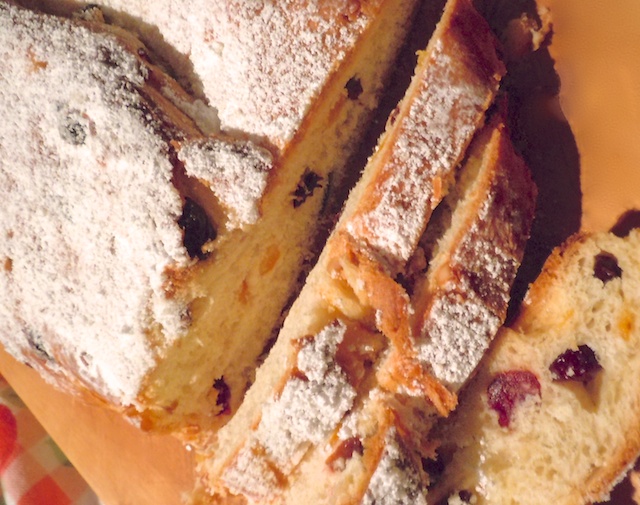 [M]any regions boast a bread that is specific to the holidays. The Italians have Panettone, a tall, slightly sweet yeast bread dotted with dried or candied fruits. The Swedish have Lucia Buns, s-shaped twists spiced with saffron and cardamom, served in honor of St. Lucia. The Germans have a curious dense loaf called Stollen, which is also a fruit and nut bread, sometimes containing sweet bits of marzipan and dusted with powdered sugar.
[M]any regions boast a bread that is specific to the holidays. The Italians have Panettone, a tall, slightly sweet yeast bread dotted with dried or candied fruits. The Swedish have Lucia Buns, s-shaped twists spiced with saffron and cardamom, served in honor of St. Lucia. The Germans have a curious dense loaf called Stollen, which is also a fruit and nut bread, sometimes containing sweet bits of marzipan and dusted with powdered sugar.
I considered all three for my bread of the month this December. But then I remembered something: I’m one-quarter German. And I buy Stollen loaves every year for my dad, who fancies them, but who is, in fact, not German. The purchased Stollen breads are usually small, heavy and very sweet. It occurred to me, that, perhaps and most likely, a homemade Stollen would be a better version of this holiday bread.
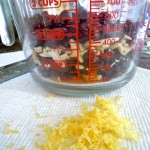 [S]tollen or Christollen is very Old World, the first known to have been made for Christmas was in the 1400s. For years, having been a part of the fasting season of the Advent, the breads were baked using oil, as no butter was allowed. When religious dictums finally relented, the butter burst into the recipe full force. According to the “Joy of Cooking,” Stollen, with it’s folded shape, represents the blanket for the Baby Jesus. Over the years it has bee made with a jolly array of sweet or candied fruits, then powdered or glazed in sweet confection. The German city of Dresden is considered the key spot of Stollen-making, with a Stollenfest taking place there every year.
[S]tollen or Christollen is very Old World, the first known to have been made for Christmas was in the 1400s. For years, having been a part of the fasting season of the Advent, the breads were baked using oil, as no butter was allowed. When religious dictums finally relented, the butter burst into the recipe full force. According to the “Joy of Cooking,” Stollen, with it’s folded shape, represents the blanket for the Baby Jesus. Over the years it has bee made with a jolly array of sweet or candied fruits, then powdered or glazed in sweet confection. The German city of Dresden is considered the key spot of Stollen-making, with a Stollenfest taking place there every year.
I decided to make a version of the Dresden Stollen, from my Sunset “Breads” book. It would produce two sumptuous loaves — one for home and one to share. Besides the fact that the dough recipe looked to be mildly sweet (not too sweet) and seemed like it would be tender given the butter and egg components, I liked the 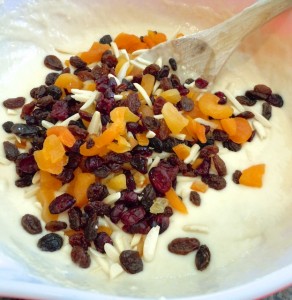 use of lemon zest and fruits and nuts. The only candied element was some orange peel which, upon tasting, I found flavorful and not sugary sweet. The recipe called for raisins, golden raisins, currants and slivered almonds. I decided to do my own combo of dried cranberries, chopped dried apricots, raisins and almonds.
use of lemon zest and fruits and nuts. The only candied element was some orange peel which, upon tasting, I found flavorful and not sugary sweet. The recipe called for raisins, golden raisins, currants and slivered almonds. I decided to do my own combo of dried cranberries, chopped dried apricots, raisins and almonds.
Mixing the fruits and nuts into the dough reminded me a little of fruitcake (see (See 12/10) blog entry), and with the lemon zest and orange peel, along with almond extract and that good yeasty bread aroma, it smelled heavenly.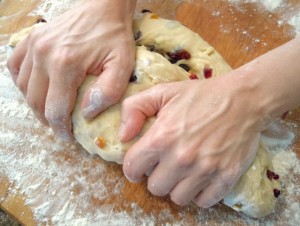
[T]he dough would require 10 minutes of kneading. Having recently made a successful batch of my mother’s yeast rolls (see blog entry of 6/12) requiring the same kneading time, I was somewhat confident in my strength and stamina. The only challenge was keeping the fruits and nuts from popping out of the dough (as they will do). As I worked the dough, sweating in a somewhat healthy rhythm, it occurred to me — finally — what my Man Mitts were meant to do. KNEAD! How nice to know they are good for something.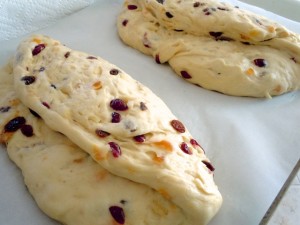
Dough kneaded, it required a rising of one hour, then another go at kneading, then shaping into the traditional folded design — the blanket. Another rising of about 45 minutes brought the loaves into ample size.
After a 25-minute baking time the golden brown loaves are brushed with more butter (!), then dusted with powdered sugar and returned to the oven for a few minutes to seal the deal. 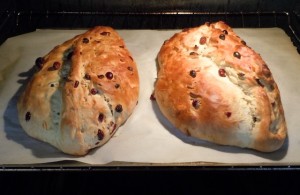 The results, with just a little bit of work, yielded Stollen loaves considerably larger than purchased versions. The taste, too, made it worth the trouble — light, tender, buttery, with bursts of fruit. The loaf I took to work was well-received and even made known to me similar souls of German heritage.
The results, with just a little bit of work, yielded Stollen loaves considerably larger than purchased versions. The taste, too, made it worth the trouble — light, tender, buttery, with bursts of fruit. The loaf I took to work was well-received and even made known to me similar souls of German heritage.
Dresden-style Stollen
From Sunset “Breads” 1991
Makes 2 loaves
1/2 cup milk
1 cup butter or margarine
1/2 cup granulated sugar
2 packages active dry yeast
1/2 cup warm water
1/2 teaspoon salt
1 teaspoon each grated lemon peel and almond extract
About 5 1/4 cups all-purpose flour
2 eggs
1/3 cup finely chopped candied orange peel
1/2 cup each raisins, golden raisins, currants and slivered almonds
1 egg white beaten with 1 teaspoon water
4 tablespoons butter or margarine, melted
1/3 cup powdered sugar
In a small pan over medium-low heat, combine milk, the 1 cup butter, and granulated sugar. Heat to scalding (120 degrees), stirring to dissolve sugar and melt butter. Set aside; let cool to lukewarm.
In a large bowl, dissolve yeast in warm water. Add cooled milk mixture, salt, lemon peel, almond extract, and 3 cups of the flour; beat until well blended. Add eggs, one at a time, beating until well-blended. Add eggs, one at a time, beating well after each addition. Gradually stir in orange peel, raisins, currants, almonds,a nd 2 cups of the remaining flour.
Turn dough out onto a floured board and knead until smooth and satiny (about 10 minutes), adding flour as needed to prevent sticking. Place dough in a greased bowl, turn over to grease top. Cover and let rise in a warm place until doubled (about 1 1/2 hours).
Punch dough down. Knead briefly on floured board to release air, then divide in half. Place each portion on a lightly greased 12 by 15-inch baking sheet and shape into a 7 by 9-inch oval about 3/4 inch thick. Brush surface with some of the egg white mixture. Crease each oval lengthwise, slightly off center, and fold so top edge lies about an inch back from bottom edge. Brush evenly with remaining egg white mixture. Cover and let rise in a warm place until puffy and almost dough led (35 to 45 minutes).
Bake in a preheated 375 degree oven for 25 minutes or until richly browned. Brush with the 4 tablespoons melted butter and sift powdered sugar over top. Return to oven and bake for 3 more minutes. Transfer to racks and let cool.
Blogger’s Note: Use a combination of dried fruits and nuts you like!